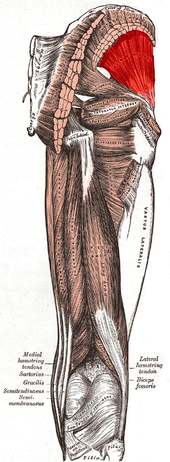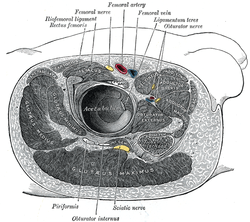Gluteus minimus muscle
| Gluteus minimus | |
|---|---|
 | |
| Gluteus minimus muscle (shown in red). Posterior view. | |
 | |
| The gluteus minimus and nearby small gluteal muscles (posterior view) | |
| Latin | musculus glutaeus minimus |
| Gray's | p.475 |
| Origin | From area in between the anterior gluteal line and inferior gluteal line of Gluteal surface ilium, under gluteus medius. |
| Insertion | Greater trochanter of the femur |
| Artery | superior gluteal artery |
| Nerve | superior gluteal nerve (L4, L5, S1 nerve roots) |
| Actions | Works in concert with gluteus medius: abduction of the hip; preventing adduction of the hip. Medial rotation of thigh. |
| Antagonist | lateral rotator group |
The gluteus minimus (or glutæus minimus), the smallest of the three gluteal muscles, is situated immediately beneath the gluteus medius.
Origin and insertion

It is fan-shaped, arising from the outer surface of the ilium, between the anterior and inferior gluteal lines, and behind, from the margin of the greater sciatic notch.
The fibers converge to the deep surface of a radiated aponeurosis, and this ends in a tendon which is inserted into an impression on the anterior border of the greater trochanter, and gives an expansion to the capsule of the hip joint. It is also a local stabilizer for the hip.
Relations
A bursa is interposed between the tendon and the greater trochanter.
Between the gluteus medius and gluteus minimus are the deep branches of the superior gluteal vessels and the superior gluteal nerve.
The deep surface of the gluteus minimus is in relation with the reflected tendon of the rectus femoris and the capsule of the hip joint.
Action
The gluteus medius and gluteus minimus abduct the thigh, when the limb is extended, and are principally called into action in supporting the body on one limb, in conjunction with the Tensor fasciæ latæ.
Their anterior fibers, by drawing the greater trochanter forward, rotate the thigh inward, in which action they are also assisted by the Tensor fasciæ latæ.
Additionally, with the hip flexed the gluteus medius and minimus externally rotate the thigh. With the hip extended, the gluteus medius and gluteus minimus internally rotate the thigh.[1]
Variations
The muscle may be divided into an anterior and a posterior part, or it may send slips to the piriformis, the superior gemellus or the outer part of the origin of the vastus lateralis.
Pathology
- Paralysis of this muscle or gluteus medius, such as may be caused by the superior gluteal nerve palsy, can lead to difficulty abducting the leg. Patients will compensate for their difficulty walking by adopting a Trendelenburg gait.
References
- ↑ Pratt, N. Clinical Musculoskeletal Anatomy. CBLS: Marietta, OH 2004.
Additional images
-

Position of gluteus minimus muscle (shown in red). Animation.
-

Close up. Hip bone is shown in semi-transparent.
-

Anterior view. Still image.
-

Structures surrounding right hip-joint. (Gluteus minimus visible at center left.)
-

Right hip bone. External surface.
-

Right femur. Anterior surface.
-

The arteries of the gluteal and posterior femoral regions.
-

Nerves of the right lower extremity Posterior view.
External links
| Wikimedia Commons has media related to Gluteus minimus muscles. |
This article incorporates text from a public domain edition of Gray's Anatomy.
| ||||||||||||||||||||||||||||||||||||||||||||||||||||||||||||||||||||||||